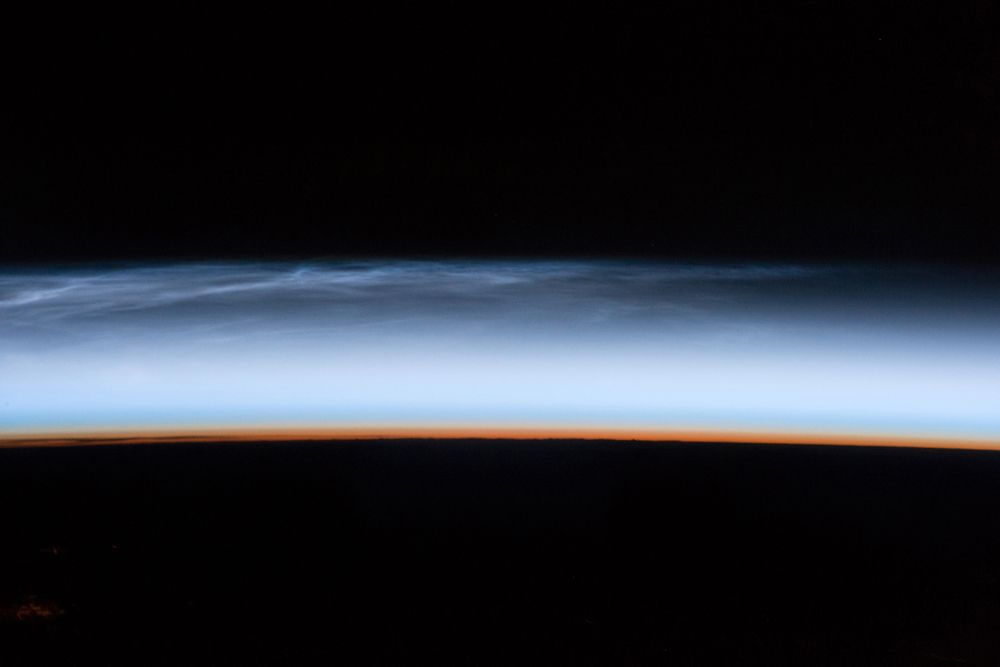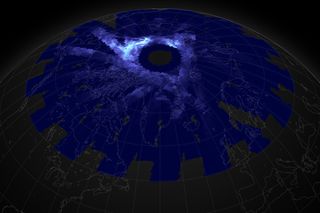Gorgeous Night-Shining Clouds Glow in New Earth Images

A silvery filigree of vapor hovers at the edge of the atmosphere in new images released by NASA.
This glowing layer is made up of noctilucent, or night-shining clouds. According to NASA's Earth Observatory, these clouds form when the lower atmosphere warms and the upper atmosphere cools, a pattern that occurs in late spring and summer. In the chilly upper atmosphere, ice crystals form on particulate matter, creating delicate bluish-white clouds.
From the ground, the clouds appear as wispy white ripples; they've been seen as far south as Denver, according to NASA's Goddard Space Flight Center. Noctilucent clouds far from the poles are a fairly new phenomenon, and may be related to rising levels of greenhouse gases in the atmosphere. Some noctilucent clouds were seen over the continental United States on June 9 and 10, according to NASA. [In Images: Mysterious Night-Shining Clouds]
From space, though, these clouds really shine.
Two new NASA images provide a view of noctilucent clouds from above. The first is a composite of satellite snapshots from NASA's Aeronomy of Ice in the Mesosphere (AIM) spacecraft, taken on June 10. Combined, the images show the albedo, or reflectiveness, of the clouds. White denotes greater reflectivity and blue less.

Two days before the satellite made its pass, an astronaut aboard the International Space Station snapped the second image of this luminous cloud layer. At the bottom of the image is Earth, swathed in darkness, with a thin band of orange sunlight along the horizon. The noctilucent clouds appear right at the edge of the blackness of space.
Noctilucent clouds are more than beautiful. They are also connected. According to a 2014 study of AIM data, there are teleconnections — long-distance correlations in atmospheric conditions — among the noctilucent cloud layer. The study researchers found that crippling cold in the northern United States was correlated with fewer noctilucent clouds in Antarctica about two weeks later.
Sign up for the Live Science daily newsletter now
Get the world’s most fascinating discoveries delivered straight to your inbox.
The reason has to do with atmospheric circulation, study leader James Russell, an atmospheric scientist at Hampton University, said in a statement. When winds in the stratosphere, the second layer of the atmosphere, slow over the Arctic, they create the sort of "polar vortex" that had northern U.S. cities shivering this past winter. The ripple effect then travels farther, causing the next layer up from the stratosphere — the mesosphere — to warm up and dry out over Antarctica. The result of the warmer, dryer mesosphere is fewer noctilucent clouds.
Noctilucent clouds "are a valuable resource for studying long-distance connections in the atmosphere," Russell said in the statement. "And we are just getting started."
In another study, detailed in a 2014 issue of the Journal of Geophysical Research: Atmospheres, researchers have found that since the turn of the century such shimmery clouds have become more common in the lower latitudes, such as southern Canada and the northern United States.
Follow Stephanie Pappas on Twitter and Google+. Follow us @livescience, Facebook & Google+. Original article on Live Science.

Stephanie Pappas is a contributing writer for Live Science, covering topics ranging from geoscience to archaeology to the human brain and behavior. She was previously a senior writer for Live Science but is now a freelancer based in Denver, Colorado, and regularly contributes to Scientific American and The Monitor, the monthly magazine of the American Psychological Association. Stephanie received a bachelor's degree in psychology from the University of South Carolina and a graduate certificate in science communication from the University of California, Santa Cruz.










